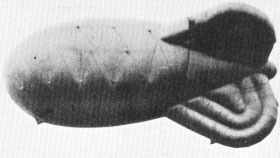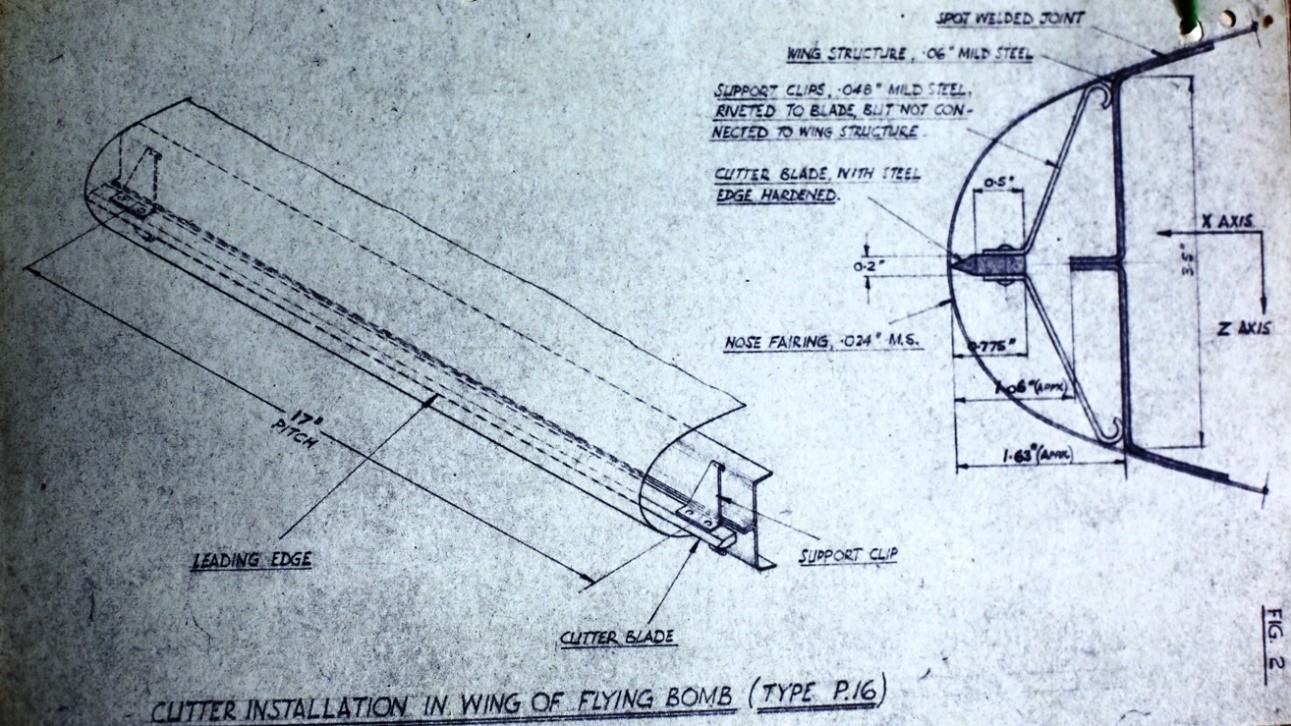 Click for Site Directory
Click for Site DirectoryOperation Crossbow
In June 1944 the V1 Flying Bomb was taxing the minds of the Armed Services. It was clear that unarmed cables were useless when hit by
a Flying Bomb at speeds in excess of 300 m.p.h., but armed cables were being found to be effective at 400 m.p.h.
The value of cables freely suspended from a balloon against flying bombs was being investigated. On 1st July 1944 a demonstration was
held at Cardington. It must have been baffling for the residents to see the various balloon combinations flown that day.

Scheme 1 used a standard Mk VII balloon on KB.5B cable. Four Dove kites in a string were flown from the crossover using KB.1A
cable.
The lower end of the cables was attached to the main flying cable. The hanging cables had weak links and parachutes fitted.
Protection was 4,000 feet of KB.5A cable and four lengths of KB.1A
Scheme 2 used a balloon on KB.32A cable. The cable was fixed at the ground, passed over a balloon pulley block and down to a
mobile winch. As the balloon was let up the winch was moved away from the fixed anchorage so as to form an inverted “V”.
Hanging from the balloon pulley block to the ground was a length of KB.1A cable fitted with weak links and parachutes. The
fixed end of the flying cable could be armed similarly but arming the length from the winch presented some difficulties.
Scheme 3 used a standard balloon flown on KB.5A cable from a winch. A single length of light cable as hung from the tail guy. The
lower end being fastened to the main flying cable. The hanging cable consisted of 3,300 feet of KB.1A cable. fitted with weak links
and parachutes, with 300 feet of 5 cwt cable being fitted at the lower end. Protection was one length of flying cable, KB.5B, and one
length of hanging cable, all up to 4,000 feet. Scheme 3(a) used a double suspended cable. Scheme 3 (b) used a treble suspended
cable.




Scheme 4 was a cable pyramid using as many wires as possible were connected between the balloon crossover
and the ground in the form of a plane pyramid, the plane being perpendicular to the direction of attack. The
suggestions were: (a) a balloon flying on four lengths of KB.1A, or
(b) a balloon flying on KB,5B with as many lengths of piano wire as possible, each wire being
armed with parachutes.
Scheme 5 was the Admiralty on using a curtain of 19-gauge wire hung between two balloons. Two standard
balloons were flown on KB,5B cable, a head rope (1300 feet of 1-ton cable) connecting the two cross-overs.
Hanging from this were 14 lengths of 19-gauge piano wire, each 1600 feet long, and two lengths of 15-gauge
wire, the lower ends being fixed to a foot rope connected between the flying cables.
The Tandem Scheme consisted of two MK VII balloons in tandem and was not restricted to any particular cable or
wire arrangement but was designed to take any particular cable configuration to a greater height.
The Whiskers Scheme was particularly popular with the higher-ups in Balloon Command. It involved flying a balloon at 3,500 feet and
some 500 feet down from the balloon a series of eight 15 S.W.G wire whiskers were attached at 150 feet intervals. At the beginning
and end of each whisker was a parachute. These whiskers were dragged out sideways in the wind and were thought to give a high
probability of bringing down a Flying Bomb.
The outcome of the demonstration was that the Balloon Development Establishment schemes all seemed to have merits and they
were to be set up and flown on the experimental sites in the barrage area defending the Flying Bombs. This would give more
practical information. The Admiralty curtain scheme was also to be tried out in the barrage area.
It was clear that no parachute in production could withstand opening at speeds of 400- 450 m.p.h. and new designs were being
trialed to overcome this.
Research had shown that the drag improved with the overall diameter at collision speeds between 300 m.p.h. to 450 m.p.h.

On the 28th June 1944 they were able to inspect a Flying Bomb that was equipped with a cable cutter.

Clearly information had been obtained by the Germans about the use of a balloon barrage to bring down Flying Bombs and so the Germans
produced cable cutting devices. Between 28th June and 4th of July some 68 Flying Bombs were inspected and only 8 seemed to have cable
cutters. The cutter was fixed to the front wing spar by clips. The cutters were not particularly robust and it was thought that they may
often have folded over on hitting a cable.
Much innovation and trial and error was needed to find the most efficient way to use balloon cables to bring down the Flying Bomb.
Without doubt this was the finest hour in the history of Balloon Command. So many famous names such as Barnes Wallace, Thomas Merton,
and Lord Ashton were major contributors to the Flying Bomb Defence.
Peter Garwood April 2018